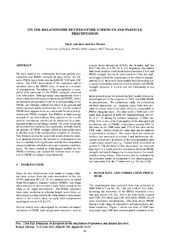On the Relationship between PMSE Strength and Particle Precipitation
Permanent lenke
https://hdl.handle.net/10037/8607Dato
2015-06Type
Journal articleTidsskriftartikkel
Peer reviewed
Sammendrag
We have studied the relationship between particle precipitation
and PMSE strength on days where we observe
PMSE layers both with the EISCAT VHF and UHF
radars. The UHF observations of the ionization and its
variation, above the PMSE layer, is used as a measure
of precipitation. Variations of the precipitation is compared
with variations of the PMSE strengths observed
with both radars. Although many cases apparently show a
clear connection between precipitation and PMSE, where
an increased precipitation leads to a strengthening of the
PMSE, our findings confirm that there is no general and
simple proportionality between the two. For the weakest
PMSE there appears to be no correlation between precipitation
and PMSE strength. For PMSEs around average
strength of our observations there appears to be a weak
positive correlation, which can be predicted by a timedependent
dust cloud charge model. On some occasions
an increased precipitation can, apparently, initially lead to
an increase of PMSE strength which at some point starts
to decline even if the precipitation continue to increase.
This feature can also be seen in the results from the statistical
analysis, however the number of occurrences is too
low to conclude with significance and the time-dependent
charge model described here does not reproduce such features.
We have studied to what degree models for the
PMSE scattering can explain the various cases of reaction
of PMSE to changes in precipitation
Beskrivelse
Proc. ‘22nd ESA Symposium on European Rocket and Balloon Programmes and Related Research’, Tromsø, Norway, 7–12 June 2015


 English
English norsk
norsk